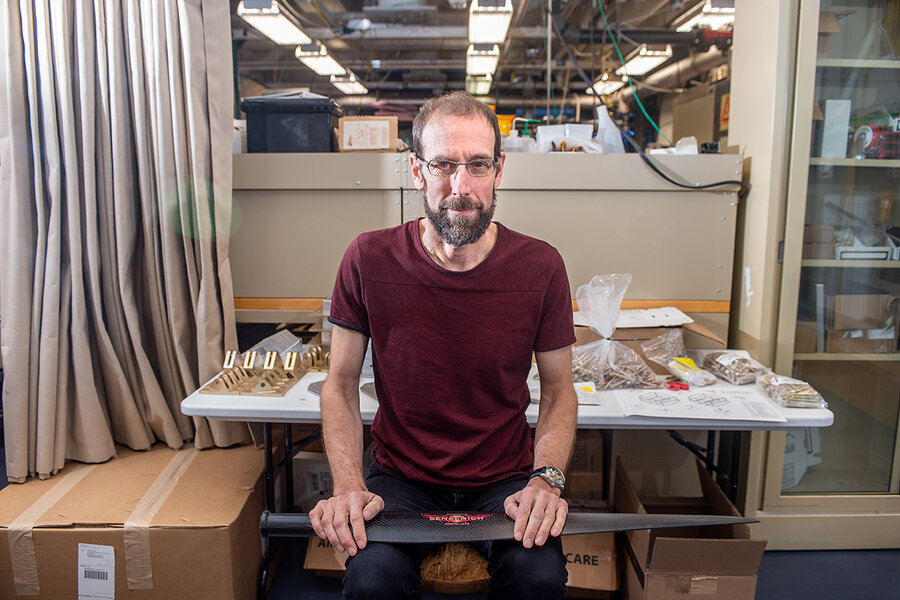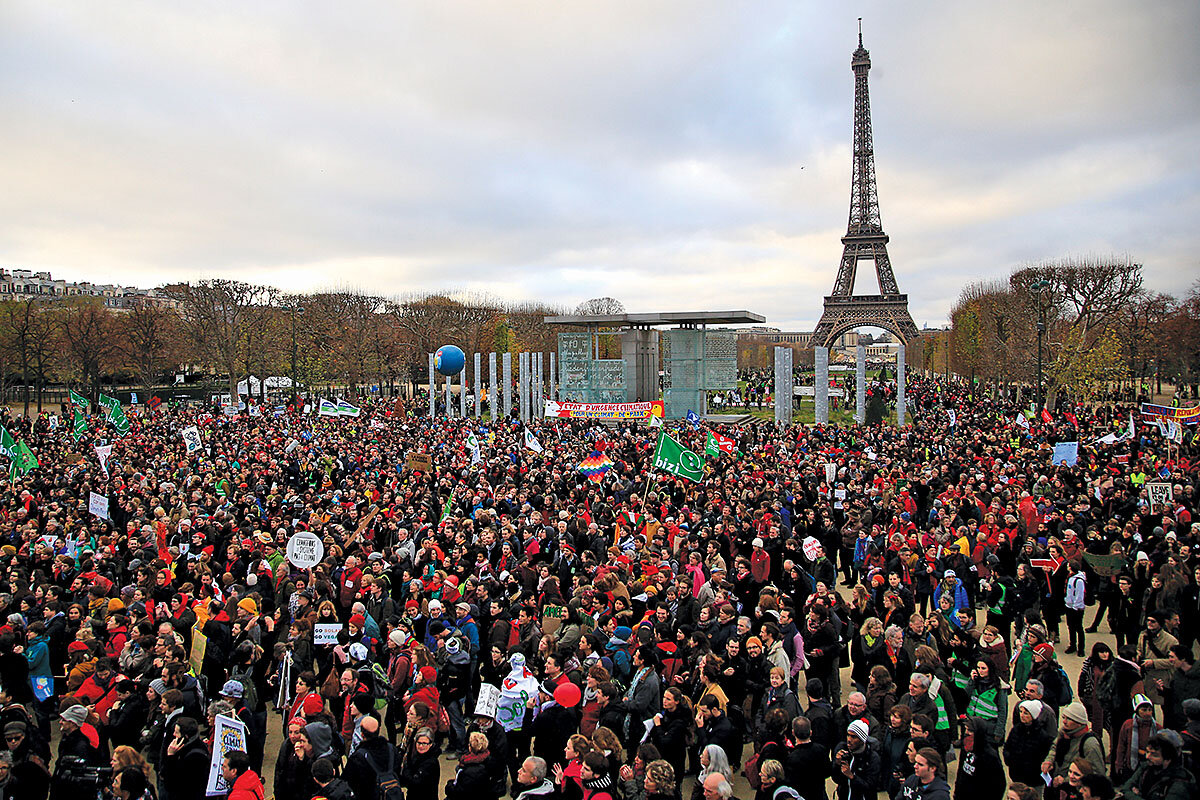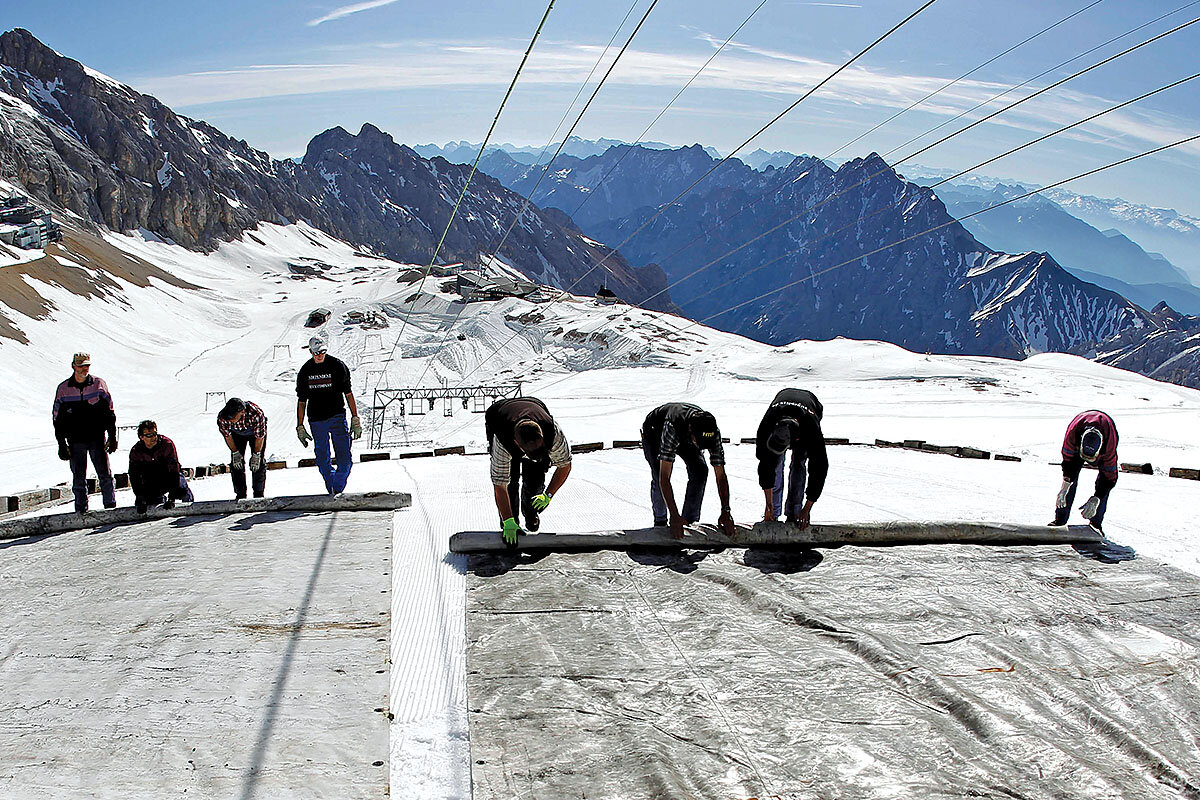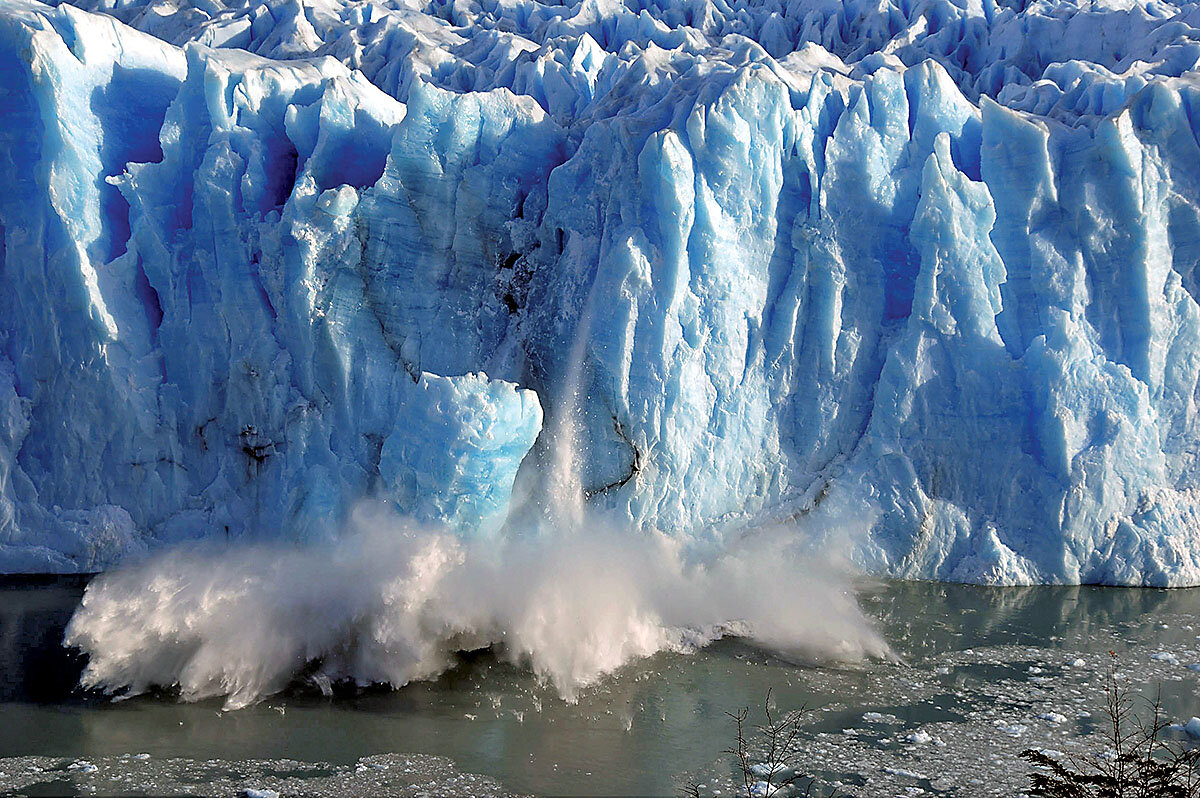Should we fiddle with Earth’s thermostat? This man might know how.
Loading...
| Cambridge, Mass.
David Keith has a radical alternative to our failure to address climate change fast enough. It’s a last resort, and he’s troubled that we may even need to risk it. His answer: Turn down the Earth’s thermostat.
Dr. Keith, a Canadian scientist-philosopher at Harvard University, is working on solar geoengineering. One idea is a fleet of planes that would release sulfur in the stratosphere, with the resulting aerosols deflecting sunlight.
Why We Wrote This
Scientists are exploring a radical idea: dimming the sun. If it works, solar geoengineering could be a last-ditch option to buy time and avert ecological disaster. But it raises ethical, legal, and geopolitical questions.
Slowing the warming of the Earth could buy time to build zero-emission economies. Assuming the idea actually works, it would require maintenance to keep dimming the sun. An abrupt stop, for starters, would crank up the thermostat at a dangerous clip.
To conservatives, the relatively modest cost of such plans is attractive. But detractors worry that progress in geoengineering research could lessen the urgency to cut global emissions.
The difficulty in finding a legitimate way to assess the risks could mean that Dr. Keith’s research never leaves the lab. He says he’s fine with that. But you can’t kill an idea. “Even if we all collectively decided in our generation that ... we better not go down this road ... that doesn’t actually bind the hands of [people in] the future. They can still do it,” he says.
On the wall of David Keith’s airy, book-lined office in Harvard University’s engineering school is a faded 3-by-3-inch card. The framed typewritten label is the badge worn by his father to the United Nations Conference on the Human Environment in Stockholm in 1972. The badge is a signpost in the long march toward global action on the environment and on climate change, which many believe has become the existential crisis of our time. Since then, scientists have mapped out the cumulative risks that a warming planet poses to humans and other species. Nations have come together to set goals for cutting greenhouse gas emissions.
News flash: The world is failing to meet them and failing fast. By almost all accounts, the cuts aren’t happening quickly enough to stop the accumulation of gases in the atmosphere at levels that are already starting to play havoc with our climate, from Sacramento to Sydney.
So Dr. Keith, a Canadian scientist-philosopher, has a radical alternative. It’s not a solution to climate change, more of a last resort, and he’s troubled that we may even need to risk it.
Why We Wrote This
Scientists are exploring a radical idea: dimming the sun. If it works, solar geoengineering could be a last-ditch option to buy time and avert ecological disaster. But it raises ethical, legal, and geopolitical questions.
His answer: Turn down the Earth’s thermostat.
Dr. Keith is among the most prominent of a small group of climate scientists working on solar geoengineering. He calls it a “brutally ugly technical fix” that offers near-term salvation in a way that could rewrite the rules of geopolitics just as nuclear weapons did in the 20th century.
He envisions a fleet of high-flying planes releasing sulfur or other chemical compounds in the stratosphere that then form an aerosol mist around the globe. These aerosols would deflect incoming sunlight, dimming the skies below. Think volcanic eruptions that blot out the sun or the meteorite dust kicked up 65 million years ago that may have led to the demise of dinosaurs.
The objective of solar geoengineering would be to slow the warming of the Earth, buying time for humans to finally stop burning fossil fuels and build zero-emission economies. Assuming the idea actually works, it would require an open-ended commitment to maintaining the dimming of the sun; an abrupt stop would crank up the thermostat at a dangerous clip. Polluting the stratosphere also risks more holes in the ozone layer, unpredictable rainfall – and perhaps other unforeseen calamities. Again, remember the dinosaurs.
Research amid skepticism
If it all sounds crazy to you, you’re not alone. Solar geoengineering was a fringe concept for most of Dr. Keith’s scientific career, one that environmentalists and most climate scientists saw as a dangerous distraction from reducing harmful emissions. He’s had death threats over his work. To critics opposed to all such research, he’s a “pantomime villain,” says Andy Parker, a climate policy researcher in the United Kingdom.
That opprobrium hasn’t stopped him from exploring solar geoengineering as well as its implications for human society. Indeed, the thorniest questions surrounding the idea lie in the realm of morality, ethics, law, and politics. Dr. Keith believes if the world ever does have to resort to using it, people should know what they’re doing – and what the effects of blotting out the sun might be.
And interest in the concept is growing. Over the past decade, solar geoengineering has moved from the cubicles of a few ridiculed researchers to the broader halls of scientific inquiry. Several countries now have research programs. In the United States most inquiries are privately funded, though in late December Congress approved $4 million to assess potential “solar climate interventions.” Dr. Keith’s program at Harvard is supported by Bill Gates and philanthropic foundations. A committee of the National Academies of Sciences, Engineering, and Medicine is due to release a two-year study in June into solar geoengineering and how it should be governed, which could unlock new federal research dollars.
“You have to be honest and look at the gap between where we are in terms of continued emissions and where we need to be, and open the door to ask whether and under what conditions we should consider these technologies,” says Peter Frumhoff, the chief climate scientist at the Union of Concerned Scientists, a nonprofit science advocacy group, and a member of the committee. “It is the worst possible way to address climate change that we need to take seriously.”
We may be able to hack the planetary thermostat. But should we? And who is “we”?
Looking for truths
With his beard, angular face, and spare 6-foot-2-inch frame, Dr. Keith would look at home on an Arctic trail or a rock face. Put him in a stovepipe hat and Victorian suit, and he could pass for Abraham Lincoln.
He grew up in Ottawa, Ontario, an only child. His father was a British-born, U.S.-educated field biologist who guided Canada’s regulation of DDT, an insecticide once hailed as a miracle substance but which became infamous for its toxic effects on the environment and humans.
Dr. Keith joined his father and stepmother, a biologist, on their field trips, and roamed 500 acres of woodland that his family partly owned. One of his uncles helped create the American Birding Association. His father’s colleague at the Canadian Wildlife Service who studied polar bears was a regular visitor at the family house. In high school, he hiked the Appalachian Trail in New Hampshire solo.
In 1989, as a physics Ph.D. student at the Massachusetts Institute of Technology, he landed on the idea of solar geoengineering as part of a group of ambitious science and policy graduate students at Harvard and MIT exploring climate change. “It was a pretty unusual group. We were kind of ahead of our professors,” he says. “I started work on this topic simply because it was a topic somebody brought up and nobody was working on it.”
Soviet scientists at the Institute of Rainmaking in Leningrad had already studied the release of particulates in the atmosphere to reflect sunlight. But it was an idea that seemed to belong more to science fiction – a fantastical parable of hubris – than to the research academy.
That didn’t deter Dr. Keith, says Hadi Dowlatabadi, who at the time was a professor of climate policy at Carnegie Mellon University in Pittsburgh and a family friend. Dr. Dowlatabadi agreed to work with Dr. Keith on a paper that tried to model a deliberate intervention in the climate system. The report, published in 1992, found a global cooling effect that previous studies had not. Solar geoengineering, in other words, appeared to work. This was not a popular idea at the time, says Dr. Dowlatabadi, who is now at the University of British Columbia in Vancouver.
“What David has always been keen on doing is trying to understand where the truth really lies, regardless of the political implications,” he says.
After completing his doctorate at MIT, Dr. Keith moved into other climate-related fields, from policy analysis to designing spectrometers for NASA aircraft. He also developed new ways to capture and store atmospheric carbon dioxide as a way to limit the effects of climate change. In 2009, he founded a Canadian startup, Carbon Engineering, backed by Mr. Gates, that builds giant fans to suck carbon from the air.
He circled back to solar geoengineering after joining Harvard in 2011 as a professor of engineering and public policy. In 2017, he became co-director of its Solar Geoengineering Research Program, which has raised $16 million so far. This has made him a lightning rod for critics of his lonely frontier of climate research.
Dr. Keith is an agile and forceful debater, and his blunt talk can raise hackles. “Many people find him to be too direct and sure of his position. But it’s rare to find that he’s wrong in his position,” says Dr. Dowlatabadi. As a scientist, though, he’s drawn to data and what can be proved.
“He comes across as having strong opinions,” says Frank Keutsch, an atmospheric chemist at Harvard. “But he’s entirely convincible.”
A volcanic effect
On July 20, 1816, The Morning Post in London informed its readers that they were not alone in experiencing a chilly, damp summer. “We continue to receive the most melancholy news from Germany on the extraordinary weather that afflicts nearly the whole of Europe.”
That month, Mary and Percy Shelley arrived in Geneva after crossing a wintry France. “Never was a scene more awfully desperate,” she wrote. The weather kept them indoors and inspired a candlelit evening of writing ghost stories at the villa of fellow poet Lord Byron. That night, Ms. Shelley conjured up a Gothic tale about a scientist whose creation escapes his control: “Frankenstein.”
The “year without a summer” was a global weather event triggered by the eruption a year earlier of Mount Tambora in Indonesia. It burped clouds of volcanic ash into the upper atmosphere that over the next year would dim the skies over Europe, Asia, and the Americas.
Nearly two centuries later, Mount Pinatubo erupted in the Philippines, spewing billions of tons of sulfur and other chemicals. Scientists estimate that eruption, in April 1991, lowered global average temperatures by 0.5 degrees Celsius, roughly half the amount of warming seen over the past century.
Stratospheric clouds formed from volcanic matter are a form of naturally occurring solar geoengineering. Yet they are still an imperfect analog for what Dr. Keith is proposing. For his concept to be tested, he needs to get outside the lab. “The only way you learn about the real world is to do experiments,” he says. “That’s how science works.”
For the past seven years he has been trying to do just that at Harvard. The Stratospheric Controlled Perturbation Experiment, or SCoPEx, would be the first such release of particles in the upper atmosphere; other experiments have occurred in Earth’s lower atmosphere. The idea is to release tiny plumes of sulfur or limestone that can be monitored to see how they behave, data that researchers can then plug into computer models to determine the effects of large-scale geoengineering.
“There’s a number of things we don’t know,” says Dr. Keutsch, who is leading SCoPEx. “How do we get to this nice, even blanket [of particles] that we put in the [computer] model? Is that even feasible?”
Diamonds and sulfur
Which chemicals to release is a matter of debate. Volcanic plumes have shown that sulfur will form reflective clouds, but it is a pollutant that destroys the ozone, which filters harmful sunlight. Dr. Keith is excited by the idea of dispersing finely milled diamonds instead. Like limestone, diamonds may form reflective clouds that do the job just as well, without the sulfur side effects.
But diamonds wouldn’t stay up there forever. They would fall to the Earth, just as sulfur does as acid rain. Would diamond particles in the soil pose health risks? How could we know?
“This might actually mean that sulfur is the right thing [to use] despite all these other exciting things because ... it really is the devil we know,” says Dr. Keith.
The experiment also poses significant engineering challenges. Dr. Keutsch is building a self-propelling gondola the size of a four-poster queen bed into which scientific instruments can fit. A balloon will loft it 12 miles into the air. After the release of the particles, the gondola then has to steer back and forth over the plumes to measure the results.
SCoPEx wouldn’t pose any danger. The aerosols released would be tiny. In fact, your last airplane flight emitted more sulfur than this experiment would. But to critics of geoengineering, SCoPEx is frightening for what it symbolizes: a privately funded stealth move toward capricious climatic meddling.
“If there’s widespread recognition that this technology is not going to solve the climate crisis ... it makes little sense to invest in experimentation,” argues Carroll Muffett, head of the Center for International Environmental Law, a Washington-based advocacy group.
Moreover, he says, SCoPEx is testing the hardware needed for a future program, while Dr. Keith and others “continue to publish papers on the economics of widespread deployment.”
“Slow and right”
To defuse these and other ethical questions, an external advisory committee will review the experiment before it can proceed, and its advice, and the Harvard team’s responses, must be published. That could mean shelving a penciled-in launch in fall 2020. “I think it’s more important to do this slow and right than rush into something,” says Dr. Keutsch. Otherwise it could become “much harder for anybody else to do future experiments.”
Geoengineering is a broad term that encompasses many different ideas about how to intervene in the Earth’s climate system. One way is to seed oceanic clouds, which would help block the sun. Another is to spread silica beads over the polar ice caps to reflect the sun’s rays. Fertilizing ocean algae, a third option, could enhance the Earth’s absorption of carbon.
Some of these methods, such as cloud seeding, would theoretically cool targeted areas of the Earth. Dr. Keith’s stratospheric approach would have global effects.
The argument for solar geoengineering is brutally utilitarian: the need to release pollutants to darken the skies, however risky, if the world doesn’t do enough to curb climate-related ecological devastation and human suffering.
Affordable stopgap?
By most accounts, the sand is already pouring through the climatic hourglass. Despite fitful efforts by many nations, global emissions are still rising – the 2010s was the warmest decade on record – and rapid decarbonization seems a political non-starter in many countries. Perhaps more ominous, the planet could warm past the danger levels of 2 degrees C above preindustrial averages with just the stock of greenhouse gases that already exists in the atmosphere.
“Even if we got emissions to zero tomorrow, we’ve still got a big climate problem,” says Dr. Keith.
At best, solar geoengineering might buy the world more decades for a social, economic, and technological transformation.
Part of the allure of the idea is that it’s relatively cheap. In a 2018 paper, Wake Smith, a former aerospace executive who teaches at Yale University, estimated the development costs of a stratospheric fleet of sulfur-releasing aircraft at $3.5 billion. This theoretical program would start in 2033 with two aircraft and 4,000 annual flights, increasing over 15 years to nearly 100 aircraft flying hundreds of flights a week. With annual operating costs of roughly $2.25 billion, or slightly more than one-quarter of what Americans spend on pet food per year, such a program would be within the means of dozens of small and large countries, or even a rich individual.
To conservatives repelled by Green New Deal-style makeovers of the U.S. economy, that’s an attractive proposition. Last September, a Wall Street Journal columnist wrote a scathing review of the solutions of Democratic presidential candidates to climate change and zeroed in on solar geoengineering – “throw a bunch of particles into the atmosphere, at a cost of perhaps $2 billion a year” – as science’s answer.
Social media and Stephen Colbert
Gernot Wagner, an associate professor of environmental studies at New York University and co-author of the 2018 paper, recalls how its findings, recast as a “solution” to climate change, ricocheted on social media. “It went viral,” he says. “It was literally trending with the Kardashians for 18 hours.”
At the time, Dr. Wagner was co-director with Dr. Keith of Harvard’s Solar Geoengineering Research Program. “One of my biggest nightmares ... was Trump waking up one day at 4 a.m. ‘Right. Found a solution to climate change. Told you so.’”
In 2013, Dr. Keith published a book-length essay, “A Case for Climate Engineering.” The book was far more equivocal than its title, but it earned him a slot on “The Late Show With Stephen Colbert,” which Dr. Keith calls “one of the more intimidating things that I’ve done.”
That night, Dr. Keith wore a dark suit and a colorful shirt with no tie. Behind his desk, Mr. Colbert cut to the chase: “How will we save the planet?” Dr. Keith outlined the basic idea behind releasing a shroud of sulfur particles in the stratosphere and what it might do to global temperatures.
“Blanketing the Earth in sulfuric acid,” says Mr. Colbert, in a mock growl, his hands tracing a sphere. “Because I’m all for it. This is the all-chocolate dinner. I still get to have my CO2 and I just need to spray sulfuric acid all over the Earth.”
Insurers call this moral hazard: People tend to take more risks because they know they are covered by insurance. Could progress in geoengineering research lessen the urgency to cut global emissions?
The real work
This is one of the chief criticisms of the concept by environmentalists and others, who see it as a dangerous distraction from the work of cutting global emissions. Critics worry about the uncertainty of it all, too: the damage hacking the climate could do to the planet. Indeed, one Oxford physicist has called solar geoengineering “wildly, utterly, howlingly barking mad.”
Alan Robock, an environmental scientist at Rutgers University, has compiled a list of 27 concerns and risks of stratospheric geoengineering, from human and ecological impacts – disrupted monsoons, reduced solar power generation – to ethics and governance. That doesn’t mean he opposes Dr. Keith’s research. “[We] have to quantify the benefits and the risks,” he says.
Who decides whether mankind should dim the sun, and under what conditions, are among the trickiest challenges. The Smith-Wagner study describes a slow ramp-up after 15 years of preparation for deployment. That could allow time to reach a global consensus on governance – say, with a U.N. resolution – and for cross-border scientific cooperation to foster partnerships.
“The world has to start talking collectively about this issue in an open and transparent way in the next few years, not later,” says Janos Pasztor, a retired U.N. diplomat who directs the Carnegie Climate Geoengineering Governance Project.
Several countries in Europe and Asia, including China and Japan, already have their own research programs. Dr. Keutsch wants to invite foreign researchers to put instruments on his stratospheric gondola so they can compare findings.
But what if a climate-related disaster strikes before a political consensus is reached? One country, or a group of countries, could decide not to wait. “It’s quite conceivable there will be unilateral action by one or more countries, for different reasons,” says Mr. Pasztor. “That has very substantial geopolitical implications.”
Indeed, the modest cost of deployment is what makes it hard to imagine that governments would pass up the option in a crisis, knowing that whatever multilateral action is taken on carbon reduction wouldn’t come quickly enough.
The geopolitical entanglements become even more complicated in deciding how much solar radiation should be deflected and then how to attribute the climatic events that follow. If devastating rains fall in China, is that the result of solar geoengineering or simply global warming? If China decides it’s the former, then it could demand a halt – belligerently. Other countries will want to keep going, not least because a sudden stop would trigger a snapback in temperatures. It may be impossible to find common ground.
As Dr. Keith put it to Mr. Colbert, “The big fear is that one country will want it one way and one will want it the other way, like two frat boys arguing over the thermostat.”
Big picture
Back in his office, his wiry frame folded onto a sofa, Dr. Keith praises the young climate activists who are pressing world leaders to act on global warming now. As an environmentalist, he shares their outrage. He also puts a moral value on the stewardship of nature, of saving rainforests and polar habitats, that goes beyond their role in our climate system. Perhaps that argument has gotten lost, he muses, in the progressive pitch to voters that tough emissions cuts will make financial sense down the road.
“We have tried that argument and it hasn’t worked,” he says. “I’ve got to believe that people care about more than just their immediate self-interest.”
In the end, the difficulty in finding a legitimate way to assess the risks of geoengineering and geopolitical conflict could mean that Dr. Keith’s research never leaves the lab. He says he’s fine with that. Perhaps carbon capture – his other passion – could take off, coupled with the rapid rollout of zero-carbon fuels powered by solar cells. The darkest near-term climatic scenarios may be averted.
But you can’t kill an idea. “Even if we all collectively decided in our generation that ... we better not go down this road and we passed a treaty saying we should never do it, that doesn’t actually bind the hands of [people in] the future. They can still do it,” he says.
This story was produced with support from an Energy Foundation grant to cover the environment.













